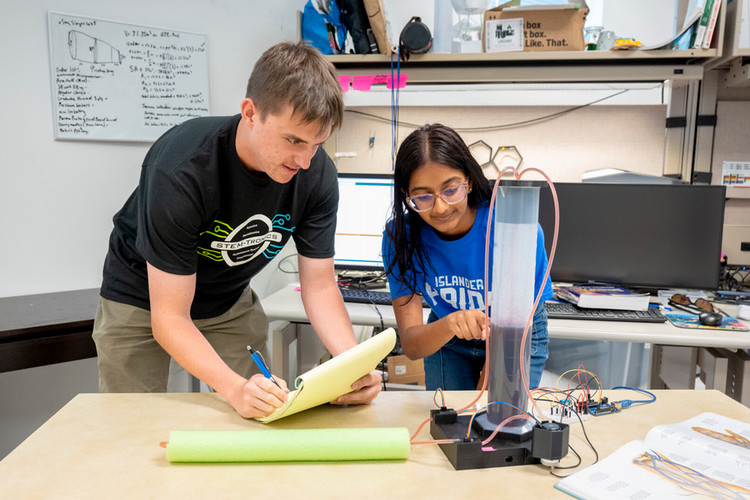Discovery Channel’s ‘Shark Week’ to Feature Island University Marine Biology Professor
CORPUS CHRISTI, Texas – Among members of the fishing community who frequent the Seven Mile Bridge in the Florida Keys, there’s an oft-heard story that’s been passed on for decades about an extraordinarily giant hammerhead shark called “Big Mo” – short for Big Mother.
While locals remain adamant that Big Mo does indeed inhabit the waters surrounding Seven Mile Bridge, hard proof – such as a photo or video footage attesting to claims of Big Mo as the largest great hammerhead ever seen – has yet to be produced.
Enter Dr. David Portnoy, Texas A&M University-Corpus Christi Associate Professor of Life Sciences and the Ruth A. Campbell Professor of Marine Biology. Portnoy's research interests include conservation genetics of exploited marine fishes, marine connectivity and patterns of zoogeography, systematics and evolution of elasmobranchs and bony fishes, and patterns of sexual selection, conflict, and speciation.
Portnoy runs the Marine Genomics Laboratory at the Island University and was contacted last fall by Hazmat Productions, the team working on a TV program for Discovery Channel’s “Shark Week”, to work on a research project as part of the TV show. “Monster Under the Bridge” airs at 7 p.m. Wednesday, Aug. 12, on Discovery Channel.
“The legend of Big Mo is what led the producers to want to tell the story,” Portnoy said. “There’s this story about an abnormally large hammerhead that patrols a bridge where locals like to fish. It’s a legend that’s apparently been around for a while.”
Listed as Critically Endangered by the International Union for Conservation of Nature’s Red List of Threatened Species, the great hammerhead is found in warm and temperate waters all over the world, including the Indian, Pacific, and Atlantic Oceans. It is the largest species of hammerhead. According to the IUCN, great hammerheads are in decline due to high mortality rates during recreational fishing and low breeding frequency – once every two years.
“We don’t know a lot about great hammerheads,” Portnoy said. “There are four large hammerhead species in the western North Atlantic Ocean; we know a good deal about scalloped hammerheads but much less about Carolina, smooth, and great hammerheads.”
Portnoy said he was asked to conduct research on a few questions regarding Big Mo: whether Big Mo was a cryptic species that would account for its large size or whether Big Mo was an individual from a population unique to the Florida Keys.
“The producers wanted us to do genetic work to complement field work they were doing,” he said.
To process and analyze samples for the project, Portnoy turned to Islander doctoral student Amanda Barker, a Graduate Research Assistant in the Marine Genomics Lab, whose research focuses on conservation genetics of scalloped and Carolina hammerheads.
Barker, who is planning to graduate this fall, said the pair worked with collaborators from universities and agencies across the Gulf of Mexico and Atlantic Coast to collect and sequence DNA from more than 300 great hammerheads.
“We look at those tiny differences in DNA in thousands of places across the genome, and this can help us learn about things like population structure, site fidelity, and adaptation to local environments,” Barker said.
Barker said the timeline to conduct her research and provide results was much quicker than the grant-funded projects she normally works on.
“I began working on this project in December 2019, and we just wrapped up the final genetics results a couple weeks ago,” she said.
Portnoy said the project revealed that scientists and researchers have much to learn about great hammerheads.
“I think what the research showed me is that we need a lot more research on great hammerheads,” said Portnoy, who plans to take his preliminary data and present it to funding agencies to provide the resources for a wider survey to generate more data. “There’s a lot of things going on in terms of habitat usage and maybe the way the stocks are managed in the U.S. waters as a whole that need to be revisited.”
Barker said she looks forward to seeing “Monster Under the Bridge” and hearing from friends and family who view the program.
“Most of the time, the only people who know about things I work on are people who study the same things as me, so it’s exciting to be involved in something that will reach such a wide audience,” she said. “Molecular work doesn’t always get a lot of attention in programs like this, and I think it’s really cool that people will get a chance to see the different tools researchers use to learn about sharks.”
Portnoy said TV programs like “Monster Under the Bridge” offer scientists a chance to discuss the need for conservation as well as the science behind the data for the benefit of a general audience.
“Nature programming – when done properly – is entertainment that helps people learn about animals, plants, or ecosystems that need to be conserved,” Portnoy said. “One of the things about this program is that there will be a conservation message associated with it. And that’s important because it informs the public about how they can help out with the effort.”
TUNE-IN: “Monster Under the Bridge” airs at 7 p.m. Wednesday, Aug. 12, on Discovery Channel
SHOW DESCRIPTION: Scientists believe that monster sharks make their home under the old Seven Mile Bridge. Fishermen claim that one of the sharks is an 18-foot-long, one-ton great hammerhead named Big Mo. If this is true, he will be the largest hammerhead on the planet. Produced by Hazmat Productions.







